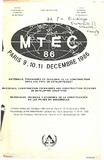| dc.contributor.author | Ondiege, P.O | |
| dc.date.accessioned | 2017-01-03T12:26:13Z | |
| dc.date.available | 2017-01-03T12:26:13Z | |
| dc.date.issued | 1986 | |
| dc.identifier.uri | http://hdl.handle.net/11295/98626 | |
| dc.description.abstract | Most of the studies have noted that urban ho~sing development
probl~~s jn Kenya are mainly due to high urban population growth
rates resulting from immigration and natural population growth, lag
in development of urban infrastructure that support housing development,
low purchasing power of the majority of the urban households
and the lack of appropriate building standards and by-laws especially
for the low-cost housing.
Heilbrun (1981) argues that the obvious and the most frequently
neglected fact is that every family must have a place to live and
that generally speaking the main function of the market is to match
up the existing number of households with the existing stock. It
has also been observed that the income of households is a major
determinant of housing units that may be supplied on the market.
Therefore the market function essentially reduces to matching up a
distribution of households by income amount with a distribution of
housing units by rent/price level.
The government policy is to discourage housing subsidies as much as
possible and encourage construction of affordable housing for various
income groups. Affordable housing implies that households are able
to pay market prices for the given housing.
The main purpose of the paper is to determine if the policy of
affordable nonsubsidized low-cost housing is realizable. Under
various assumptions, we estimate and analyze the affordability of
some of the housing programs that are being financed by the public
sector and the international agencies over the plan period 1979-83
by the lower and middle income households at market prices. In this
paper we assume that households spend between 15% and 25% of their
income on housing, PRENT. Each income group is subdivided into
three subgroups.
This paper is divided into five sections. It demonstrates that the
lower and middle income families would afford some of these housing
projects under the assumption that PRENT = 25%. However, the very
low income group would afford none of these projects. It is noted
that cost, offer and bid price functions if properly specified and
estimated as well as knowledge of the wage/income structure in the
urban areas would provide a better guide to formulation of building
standards and by-laws. Gentrification process possibilities are not
ruled out as about 75% of these projects are targeted at the mid-low
and upper-low income groups and only 12% of them are for the middle
income households. | en_US |
| dc.language.iso | en | en_US |
| dc.publisher | University Of Nairobi | en_US |
| dc.rights | Attribution-NonCommercial-NoDerivs 3.0 United States | * |
| dc.rights.uri | http://creativecommons.org/licenses/by-nc-nd/3.0/us/ | * |
| dc.subject | Construction Techniques And Construction Economy | en_US |
| dc.title | Materials, Construction Techniques And Construction Economy In Developing Countries | en_US |
| dc.type | Other | en_US |



